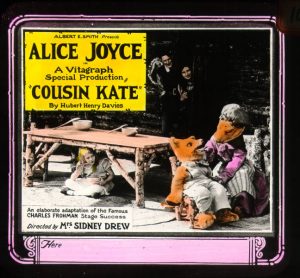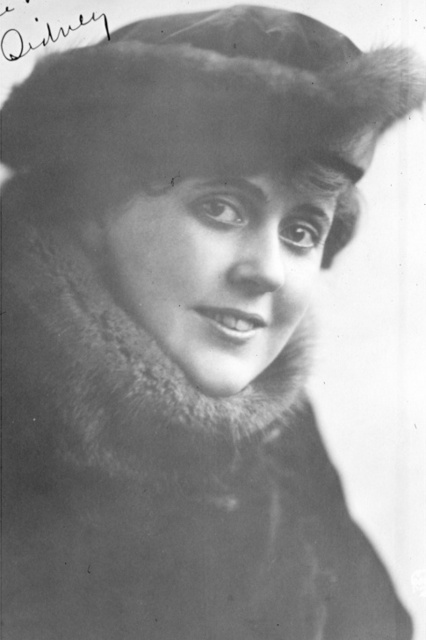by
Casiana Ionita
There were two Mrs. Sidney Drews. Both wrote for their husband’s films. The first wife, Gladys Rankin, was a dramatist who wrote under the name of George Cameron. Her play became the scenario for Sidney Drew’s first motion picture The Still Voice (1913). After the death of the first Mrs. Sidney Drew in January 1914, Sidney Drew married Lucille McVey the following July. The second Mrs. Drew, who also used the name Jane Morrow, began her career as a stage actress and then joined Vitagraph in early 1914. That same year she was part of Sidney Drew’s company of players.
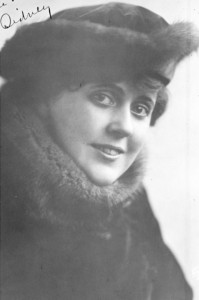
Lucille McVey (Mrs. Sidney Drew) portrait. Private Collection.
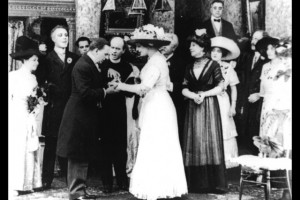
Mrs. Sidney Drew. Courtesy of the British Film Institute.
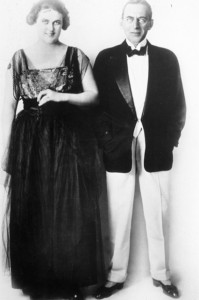
Mr. and Mrs. Sidney Drew. Private Collection.
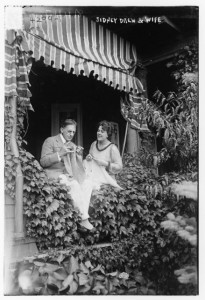
Mr. and Mrs. Sidney Drew outside of their home. Courtesy of the Library of Congress.
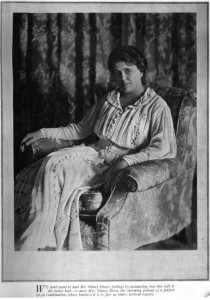
Mrs. Sidney Drew in Photoplay, January 1918.
Sidney Drew was already established as an urbane and irreverent comedy actor-director, whose work is perhaps epitomized in the semi-scandalous race and gender-bending The Florida Enchantment (1914), which he directed at Vitagraph. The Drews (Lucille and Sidney) created their own style of domestic comedies, playing an on-screen couple, Polly and Henry, the woman towering over the man, poking fun at middle-class married life. Unlike the bawdy female partners played by Mabel Normand, Marie Dressler, and Alice Howell to make working-class couples look stupid, Mrs. Drew’s haughty matron helped to make middle-class couples look ridiculous. The extant Nothing to Wear (1917), for instance, is based on the premise that a woman with some money has entirely too much to wear, and her protest that she has “nothing to wear,” produces the inevitable exercise in comic futility for the brow-beaten husband seeking to please. In their 1917 Photoplay interview, the Drews explained that writing about a couple and impersonating one on the screen made the films seem more real to the viewers, who already knew that they were husband and wife (28).
The couple worked for Vitagraph from 1914 to 1916, and then signed a contract with Metro Pictures Corporation to produce a one-reel comedy every week, at a yearly joint salary of $90,000. During that time, they refined their Henry and Polly comedies and attempted to make their weekly quota. Among the “Henry” titles are Too Much Henry, Why They Left Home/Why Henry Left Home, and Shadowing Henry, all produced in 1917. According to the Moving Picture World, of the four one-reel comedies that Metro released in one month, March 1917, three were Drew comedies (159). After their year-long contract with Metro ended, the Drews returned to the stage and also founded their own production company, V.B.K. Film Corporation. That same year, they signed a contract for a series of two-reel comedies to be released through Paramount Pictures (Mahar 2006, 121).
After her husband’s death in 1919, Mrs. Sidney Drew continued to work for another year, and she is praised for this in a 1920 Ladies Home Journal article on women motion picture and theatrical directors. This same article is one source of the information that in 1920 she wrote, directed, and produced an entire series of six comedy shorts for the US-owned Pathé Company; however, it is unclear whether all were actually made (Mahar 2006, 121). In 1921, now on her own, Mrs. Sidney Drew directed the five-reel Vitagraph comedy feature Cousin Kate (1921) starring Alice Joyce, but it is her last credit. Some of her work after Sidney’s death is described as having the same Drew comedy charm, but the fate of both of the Drews, even before Sidney’s death, also had to do with the fate of silent film comedy in this period. The heyday of the Drew comedy shorts, 1914–1917, was the period of transition from short one-reel films to multireel films. While dramatic subject matter after 1915 was elongated from one-reel shorts to six-reel features, only the few high visibility comedians, most notably Buster Keaton and Charlie Chaplin, made this transition. Mr. and Mrs. Drew, however, made the five-reeler Playing Dead at Vitagraph in 1915. The many silent film comedians who may have attempted the longer form as well as continued to make one- and two-reel short attractions into the 1920s have received little historical attention (Koszarski 1990, 174). The two-reel Drew comedies produced for Paramount would be understood as auxiliary to the feature, as would Mrs. Drew’s Pathé shorts. The continued demand for the short comedy genre in the silent era, then, needs to be considered when assessing Mrs. Drew’s career, taking account of the fast pace of producing so many titles under the conditions of the short-term contracts the Drews worked under after they left the Vitagraph studio.
The question of the division of labor within husband and wife teams is also relevant with the Drews as it is with other couples such as Mrs. George Randolph Chester and her husband. Both couples were inseparable collaborators in their productive years. But Lucille McVey is different in the way she continued as “the Drews” when she worked on her own as sole producer and director. Since scholars agree that “who did what” is a difficult question, particularly in the early 1910s when motion picture work was more fluid on the whole, we need to take a critical stance. Thus, we might also consider the sources of information about women’s contributions, asking whether they tend to exaggerate or help to rectify the record. In the case of Mrs. Sidney Drew, for instance, fan magazines and women’s magazines, the major sources of biographical information about female scenarists and directors during the silent era, tend to emphasize her contribution and de-emphasize her husband’s. The writer in Photoplay gives Mrs. Drew seventy-five per cent of the credit for the conception of the Drew comedies and describes her husband as the one who transposed her ideas on the screen (28). Henry MacMahon, looking back at Lucille’s career, sums up her work as exhaustively doing everything: “She was the one writing the scenario, directing the settings, providing the costumes, properties and furniture, coaching the actors, and managing the lights and picture-taking” (13). Perhaps what is needed is an analysis of Lucille McVey with and without Sidney Drew. She continued to write, produce, direct, and act after her husband’s death, preferring to keep his name, probably in order to keep their audience. But we should ask if the four films she produced and directed without him—The Charming Mrs. Chase (1920), The Stimulating Mrs. Barton (1920), The Emotional Mrs. Vaughan (1920), and Cousin Kate—were as “wholesome” as the press liked to describe their work as a couple. Comparing the features she made without Sidney Drew to those they worked on together would show us the extent to which she preserved or refashioned the core ideas they had developed as a couple.
See also: Mrs. George Randolph Chester, Marie Dressler, Alice Howell, Mabel Normand
Bibliography
“Four Metros for March.” Moving Picture World vol. 31, no. 8 (10 March 1917): 159.
Mahar, Karen. Women Filmmakers in Early Hollywood. Baltimore: The Johns Hopskins University Press, 2006.
MacMahon, Henry. “Women Directors of Plays and Pictures.” Ladies Home Journal (Dec. 1920): 12-14; 143-145.
Seldes, Gilbert. The Seven Lively Arts. New York, London: Harper & Brothers, 1924.
Slide, Anthony. The Big V: A History of the Vitagraph Company. Metuchen, N.J.: Scarecrow Press, 1976.
Smith, Frederic James. “Seeking the Germ. An Interview with the Sidney Drews.” Photoplay (Sept. 1917): 27-30.
Archival Paper Collections:
J. Stuart Blackton material, 1909-1939. Academy of Motion Picture Arts and Sciences, Margaret Herrick Library.
J. Stuart Blackton papers, 1912-1962. Academy of Motion Picture Arts and Sciences, Margaret Herrick Library.
Filmography
A. Archival Filmography: Extant Film Titles:
1. Mrs. Sidney Drew as Actress
Auntie’s Portrait. Dir.: George D. Baker (Vitagraph US 1914) cas.: Sidney Drew, Jane Morrow, si, b&w. Archive: UCLA Film & Television Archive, Lobster Films.
A Florida Enchantment. Dir.: Sidney Drew (Vitagraph US 1914) cas.: Sidney Drew, Edith Storey, Charles Kent, Jane Morrow, si, b&w, 35mm. Archive: Library of Congress.
The Mysterious Mr. Davey. Dir.: Sidney Drew (Vitagraph US 1914) cas.: Sidney Drew, Jane Morrow, si, b&w. Archive: Library of Congress.
Professional Scapegoat. Dir.: Sidney Drew (Vitagraph US 1914) cas.: Sidney Drew, Jane Morrow, si, b&w. Archive: BFI National Archive, UCLA Film & Television Archive.
Professor’s Romance. Dir.: Sidney Drew (Vitagraph US 1914) cas.: Sidney Drew, Jane Morrow, Cortland Van Deusen, Ethel Lee, si, b&w. Archive: George Eastman Museum, UCLA Film & Television Archive.
Between the Two of Them. Dir.: Sidney Drew (Broadway Star Features Co./Vitagraph US 1915) cas.: Sidney Drew, Jane Morrow, Cortland Van Deusen, Mary Maurice, si, b&w, 35mm. Archive: Library of Congress.
Boobley’s Baby. Dir.: Sidney Drew (Vitagraph US 1915) cas.: Sidney Drew, Jane Morrow, si, b&w, 35mm. Archive: Library of Congress.
By Might of His Right. Dir.: Sidney Drew (Drew/Metro US 1915) cas.: Sidney Drew, Jane Morrow, Donald MacBride, si, b&w. Archive: BFI National Archive.
Cupid’s Column. Dir.: Sidney Drew (Vitagraph US 1915) cas.: Sidney Drew, Jane Morrow, Cortland Van Deusen, Ethel Lee, si, b&w, 35mm. Archive: Museum of Modern Art.
The Deceivers. Dir.: Sidney Drew (Vitagraph US 1915) cas.: Sidney Drew, Mrs. Sidney Drew, Edward Favor, si, b&w. Archive: BFI National Archive.
Fox-Trot Finesse. Dir.: Sidney Drew (Vitagraph US 1915) cas.: Sidney Drew, Jane Morrow, Ethel Lee, si, b&w. Archive: George Eastman Museum, Library of Congress, Academy Film Archive.
His Wife Knew About It. Dir.: Sidney Drew (Drew / Metro US 1915) cas.: Sidney Drew, Jane Morrow, si, b&w. Archive: BFI National Archive.
Miss Sticky-Moufie-Kiss. Dir.: Sidney Drew (Vitagraph US 1915) cas.: Sidney Drew, Jane Morrow, si, b&w. Archive: George Eastman Museum, UCLA Film & Television Archive.
A Safe Investment. Dir.: Sidney Drew (Vitagraph US 1915) cas.: Sidney Drew, Jane Morrow, Donald MacBride, si, b&w, 35mm. Archive: Library of Congress, Museum of Modern Art, UCLA Film & Television Archive, Academy Film Archive, Lobster Films.
Story of a Glove. Dir.: Sidney Drew (Vitagraph US 1915) cas.: Sidney Drew, Jane Morrow, Courtland Van Deusen, si, b&w. Archive: BFI National Archive.
Wanted, A Nurse. Dir.: Sidney Drew (Vitagraph US 1915) cas.: Sidney Drew, Mrs. Sidney Drew, si, b&w, 16mm. Archive: Private Collection.
Free Speech. Dir.: Sidney Drew (Drew / Metro US 1916) cas.: Sidney Drew, Mrs. Sidney Drew, si, b&w. Archive: George Eastman Museum.
Help. Dir.: Sidney Drew (Drew/Metro US 1916) cas.: Sidney Drew, Mrs. Sidney Drew, si, b&w. Archive: Private Collection.
His First Tooth. Dir.: Sidney Drew (Drew/Metro US 1916) cas.: Sidney Drew, Mrs. Sidney Drew, si, b&w. Archive: Private Collection.
Number One. Dir.: Sidney Drew (Drew/Metro US 1916) cas.: Sidney Drew, Mrs. Sidney Drew, Paul West, si, b&w, 35mm. Archive: Library of Congress.
System is Everything. Dir.: Sidney Drew (Drew/Metro US 1916) cas.: Sidney Drew, Mrs. Sidney Drew, si, b&w, 35mm. Archive: Library of Congress.
Taking a Rest. Dir.: Sidney Drew (Drew / Metro US 1916) cas.: Sidney Drew, Mrs. Sidney Drew, si, b&w. Archive: George Eastman Museum, Library of Congress, Academy Film Archive.
Her Obsession. Dir.: Sidney Drew, sc.: Sidney Drew (Drew / Metro US 1917) cas.: Sidney Drew, Mrs. Sidney Drew, si, b&w. Archive: George Eastman Museum.
The Pest. Dir.: Arvid E. Gillstrom (King-Bee Films Corp. US 1917) cas.: Billy West, si, b&w, 35mm. Archive: Library of Congress.
Professional Patient. Dir.: Sidney Drew (Vitagraph US 1917) cas.: Sidney Drew, Mrs. Sidney Drew, si, b&w. Archive: Museum of Modern Art.
2. Mrs. Sidney Drew as Screenwriter and Actress
Playing Dead. Dir.: Sidney Drew (Vitagraph US 1915) cas.: Sidney Drew, Mrs. Sidney Drew, Donald Hall, si, b&w, 35mm. Archive: Library of Congress.
3. Mr. and Mrs. Sidney Drew and Co-Director/Co-Screenwriters and Actors
A Close Resemblance. Dir./sc: Sidney Drew, Mrs. Sidney Drew (Metro-Drew Comedies US 1917) cas.: Mr. and Mrs. Sidney Drew, si, b&w. Archive: BFI National Archive.
Her Anniversaries. Dir./sc: Sidney Drew, Mrs. Sidney Drew (Metro Pictures Corp. US 1917) cas.: Mr. and Mrs. Sidney Drew, si, b&w. Archive: Library of Congress.
Lest We Forget. Dir./sc: Sidney Drew, Mrs. Sidney Drew (Metro Pictures Corp. US 1917) cas.: Mr. and Mrs. Sidney Drew, si, b&w, 35mm. Archive: George Eastman Museum.
Nothing to Wear. Dir./sc: Sidney Drew, Mrs. Sidney Drew (Metro-Drew Comedies US 1917) cas.: Sidney Drew, Mrs. Sidney Drew, si, b&w. Archive: UCLA Film & Television Archive.
Safety First. Dir./sc: Sidney Drew, Mrs. Sidney Drew (Metro Pictures Corp. US 1917) cas.: Mr. and Mrs. Sidney Drew, si, b&w.. Archive: George Eastman Museum.
Twelve Good Hens and True. Dir./sc: Sidney Drew, Mrs. Sidney Drew (Metro Pictures Corp. US 1917) cas.: Mr. and Mrs. Sidney Drew, si, b&w. Archive: Cinemateca Romana.
Unmarried Look. Dir./sc: Sidney Drew, Mrs. Sidney Drew (Metro Pictures Corp. US 1917) cas.: Mr. and Mrs. Sidney Drew, si, b&w.. Archive: George Eastman Museum.
B. Filmography: Non-Extant Film Titles:
1. Mrs. Sidney Drew as Actress
Bunny’s Scheme, 1914; Innocent But Awkward, 1914; Never Again, 1914; Rainy the Lion Killer, 1914; The Royal Wild West, 1914; Too Many Husbands, 1914; William Henry Jones’ Courtship, 1914; All for the Love of a Girl, 1915; Back to the Primitive, 1915; Beautiful Thoughts, 1915; A Case of Eugenics, 1915; The Combination, 1915; The Cub and Daisy Chain, 1915; Diplomatic Henry, 1915; Following the Scent, 1915; The Hair of Her Head, 1915; The Home Cure, 1915; The Homecoming of Henry, 1915; The Honeymoon Baby, 1915; How John Came Home, 1915; Is Christmas a Bore?, 1915; Mr. Blink of Bohemia, 1915; The Professional Diner, 1915; The Professor’s Painless Cure, 1915; Romantic Reggie, 1915; Rooney’s Sad Case, 1915; Their Agreement, 1915; Their First Quarrel, 1915; The Timid Mr. Tootles, 1915; Unlucky Lovey, 1915; When Dumleigh Saw the Joke, 1915; When Greek Meet Greek, 1915; At the Count of Ten, 1916; Borrowing Trouble, 1916; Childhood’s Happy Days, 1916; Crosby’s Rest Cure, 1916; Duplicity, 1916; Gravy, 1916; Henry’s Thanksgiving, 1916; His Rival, 1916; His Wife’s Mother, 1916; The Jones’ Auto, 1916; A Lady in the Library, 1916; The Model Cook, 1916; It Never Got By, 1916; Nobody Home, 1916; One on Henry, 1916; Preparedness, 1916; Sweet Charity, 1916; The Swooners, 1916; A Telegraphic Tangle, 1916; Their Divorce, 1916; Their First, 1916; Too Clever by Half, 1916; When Two Play a Game, 1916; Caveman’s Buff, 1917; His Perfect Day, 1917, Financing the Fourth, 1918.
2. Mrs. Sidney Drew as Director, Producer, Screenwriter and Actress
Bunkered, 1919; The Charming Mrs. Chase, 1920; The Emotional Mrs. Vaughn, 1920.
3. Mrs. Sidney Drew as Director
The Stimulating Mrs. Barton, 1920; Cousin Kate, 1921.
4. Mr. and Mrs. Sidney Drew as Co-Director, Co-Screenwriter, Co-Producer and Actors
A Sisterly Scheme, 1919; Squared, 1919.
5. Mr. and Mrs. Sidney Drew as Co-Director, Co-Screenwriter, Actors
As Others See Us, 1917; The Dentist, 1917; Henry’s Ancestors, 1917; Her Economic Independence, 1917; Her First Game, 1917; Her Lesson, 1917; His Curiosity, 1917; His Deadly Calm, 1917; His Double Life, 1917; His Ear For Music, 1917; His First Love, 1917; Hist! Spies, 1917; The Hypochondriacs, 1917; The Joy of Freedom, 1917; The Match Maker, 1917; Mr. Parker—Hero, 1917; Music Hath Charms, 1917; The Patriot, 1917; The Rebellion of Mr. Minor, 1917; Rubbing It In, 1917; Shadowing Henry, 1917; The Spirit of Merry Christmas, 1917; Too Much Henry, 1917; Tootsie, 1917; Wages No Object, 1917; After Henry, 1918; Before and After Taking, 1918; The Bright Lights Dimmed, 1918; Gas Logic, 1918; Help Wanted, 1918; His First Love, 1918; His Generosity, 1918; His Strength of Mind, 1918; Pay Day, 1918; Special Today, 1918; Their Mutual Motor, 1918; Under the Influence, 1918; When a Man’s Married, 1918; Why They Left Home/Why Henry Left Home, 1918; A Youthful Affair, 1918; Amateur Liar, 1919; Harold, the Last of the Saxons, 1919; Once a Mason, 1919; Romance and Rings, 1919.
D. DVD Sources:
Accidentally Preserved Vol. 3 (Undercrank Productions US 2018) - includes Wanted, A Nurse.
Credit Report
For the first two years of her career as a screen actress (1914 and most of 1915), Lucille McVey used the name Jane Morrow. From 1916 until her death, she was constantly billed as Mrs. Sidney Drew, but newspapers and magazines sometimes referred to her as Lucille McVey Drew or Lucille Drew. We have attempted to create a complete filmography from FIAF, AFI, Spehr, and Braff records as well as from biographies on the Barrymores and collections on vaudeville performers; however, we recognize that this entry has numerous inconsistencies, as fifty plus titles only appear in one reference book and cannot be confirmed in other sources. The second Mrs. Sidney Drew (Lucille McVey) is credited as Jane Morrow in almost all films until 1916. She is also constantly confused with the first Mrs. Sidney Drew (Gladys Rankin). Books on vaudeville and the Barrymores further the confuse the issue by assuming there is only one Mrs. Sidney Drew or listing McVey’s first name as Polly or claiming the first Mrs. Drew appeared with her husband in films. Both Mrs. Drews wrote films for Mr. Drew; however, the first Mrs. Drew, who had been Mr. Drew’s stage partner, did not appear on screen. To complicate things even more, Braff credits Gladys Rankin as an actress in nearly twenty entries that clearly starred Lucille McVey; the dates alone make it impossible, as the films were made in 1916 and Gladys Rankin died in 1914. Two titles, Help and His First Tooth (both 1916), are extant, but have no archival sources, as they exist in a private collection.
Citation
Ionita, Casiana. "Mrs. Sidney Drew." In Jane Gaines, Radha Vatsal, and Monica Dall’Asta, eds. Women Film Pioneers Project. New York, NY: Columbia University Libraries, 2013. <https://doi.org/10.7916/d8-v5hc-2j62>
